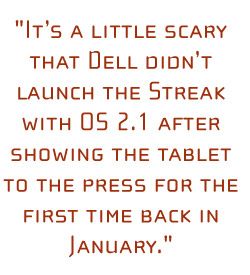Can Dell Get On a Hot Streak?

How does a PC maker entering the smart phone space for the first time make a splash? Make a device so large other people can’t help but ask “What the heck is that?” To be fair, Dell positions its new 5-inch Streak as a tablet that happens to make calls. But that hasn’t stopped people from comparing it to a waffle or a Pop Tart (it’s bigger than the latter) while holding it up to their head. The good news is that the Streak is a well-designed slate, complete with a front-facing camera for video calls, and it’s the first Android tablet that can access the Android Market. But what’s missing from this first effort makes we wonder whether the company can compete with the big boys.
Back in February Dell’s general manager of tablets, Neeraj Choubey, told me that Dell would be rolling out a service that allows consumers to buy content once and have it be available on multiple Dell devices. A leaked flyer for the device in March pointed to a possible partnership with Amazon for books, movies, and music. Sure, Amazon MP3 and the Kindle app work fine on the Streak, but they’re not truly integrated with the device or other Dell gear. More importantly, at least for now this tablet-phone doesn’t tie into any video service out of the box, a pretty big omission when you have such a large screen. Samsung will debut just such a service this fall for its new Galaxy S phones called Media Hub.
The bigger issue is that the Streak runs last year’s software. Although Dell’s customized Android interface works fairly well, it’s powered by OS 1.6. To put that in perspective, when the Motorola Droid launched in October of 2009, it ran Android 2.0. This deficiency likely has a lot to do with the Streak’s sluggish performance, despite the fact that it has the same 1-GHz processor under the hood as the faster HTC Evo 4G. I appreciate that Dell enabled features like pinch-to-zoom in the browser and Exchange support, but you don’t get features like speech-to-text or pinch-to-zoom in maps. It’s a little scary that the company didn’t launch the Streak with OS 2.1 after showing the tablet to the press for the first time back in January. And while HTC and Motorola promise to roll out the even faster Android 2.2 software in August for their flagship phones, Dell could only tell me that it will offer an update “later this year.” (I hope the September rumors are true.)

So is the Streak a dud before it even goes on sale? Not necessarily. Dell can pick up the pace and round out this device over time. And I like that the company will be offering accessories right off the bat, such as an HDMI dock. But user-generated content alone won’t cut it. Dell needs to provide one or more content partners for consumers to get the most out of that massive screen, especially if it decides to charge a premium over other so-called superphones with 4-inch or larger displays.
Of course, Dell didn’t set up dell.com/mobile to sell a single tablet. The company is working on a broad portfolio of mobile devices, ranging from smaller Android and Windows Phone 7 handsets to larger 7- and 10-inch slates (according to reports). The next gadget out of the gate will be the Aero from AT&T, which the company claims is the world’s lightest Android phone (at 3.7 ounces). It, too, will sport a customized interface, as well as Flash Lite support for streaming video. But, like the Streak, the Aero will ship with dated software, OS 1.5. That means at launch it won’t even be able to deliver free spoken directions via Google Maps. Wow.
Going forward, Dell’s smart phone portfolio looks better—if you believe the leaked info out there. The Dell Lightning, a Windows Phone 7 device, is said to sport a 4.1-inch OLED screen and a slide-out keyboard. Meanwhile, the Android-powered Thunder will reportedly boast the same high-quality display along with a dedicated Hulu app (now we’re talking). We also like the looks of the Stage user interface, which puts important info front and center. On the tablet front, Dell is likely working on Android slates powered by Nvidia’s Tegra chip, promising great media playback and full Flash support.
For now, Dell’s mobile execution seems lacking, but the company can turn things around. It just needs to ensure that it can differentiate its wares, while still providing the latest and greatest Android software. And the company must deliver on its promise to make it easy for consumers to enjoy the media content they buy across all of Dell’s mobile devices—regardless of the platform. After all, they still sell laptops, too.
Stay in the know with Laptop Mag
Get our in-depth reviews, helpful tips, great deals, and the biggest news stories delivered to your inbox.
Editor-in-chief Mark Spoonauer directs LAPTOP's online and print editorial content and has been covering mobile and wireless technology for over a decade. Each week Mark's SpoonFed column provides his insights and analysis of the biggest mobile trends and news. You can also follow him on Twitter.
